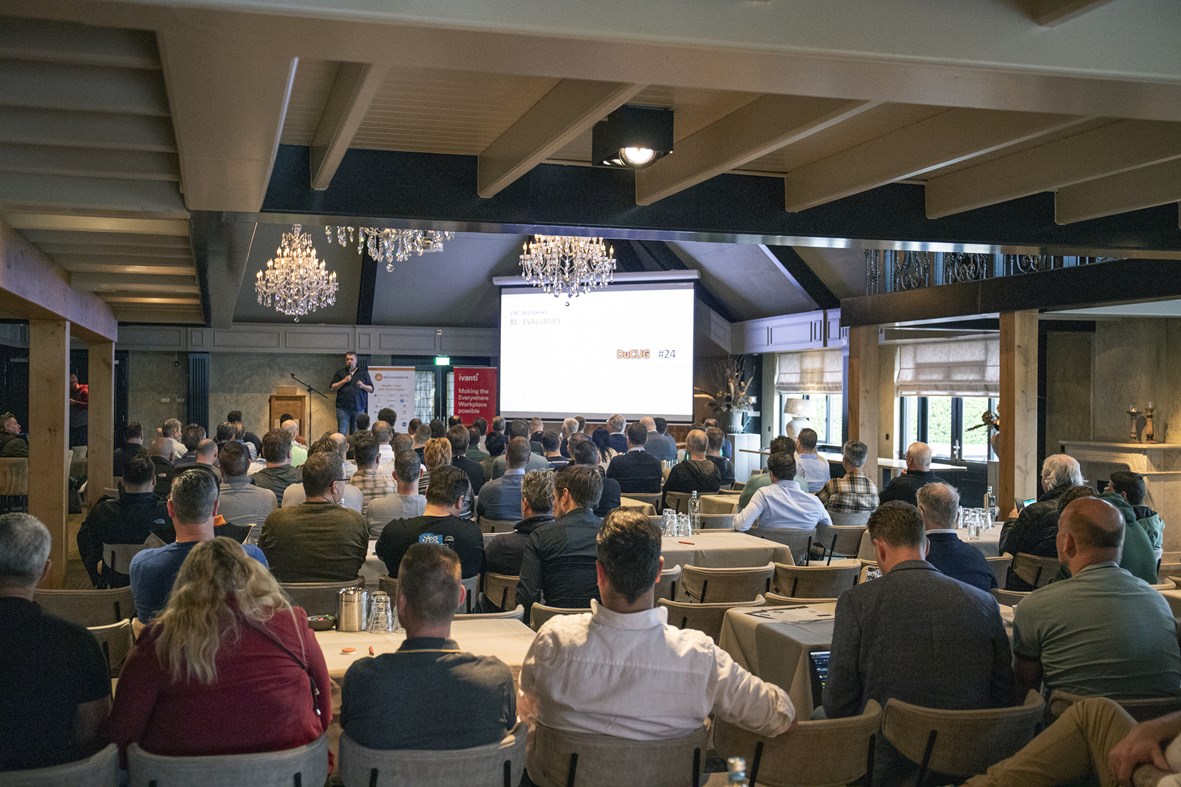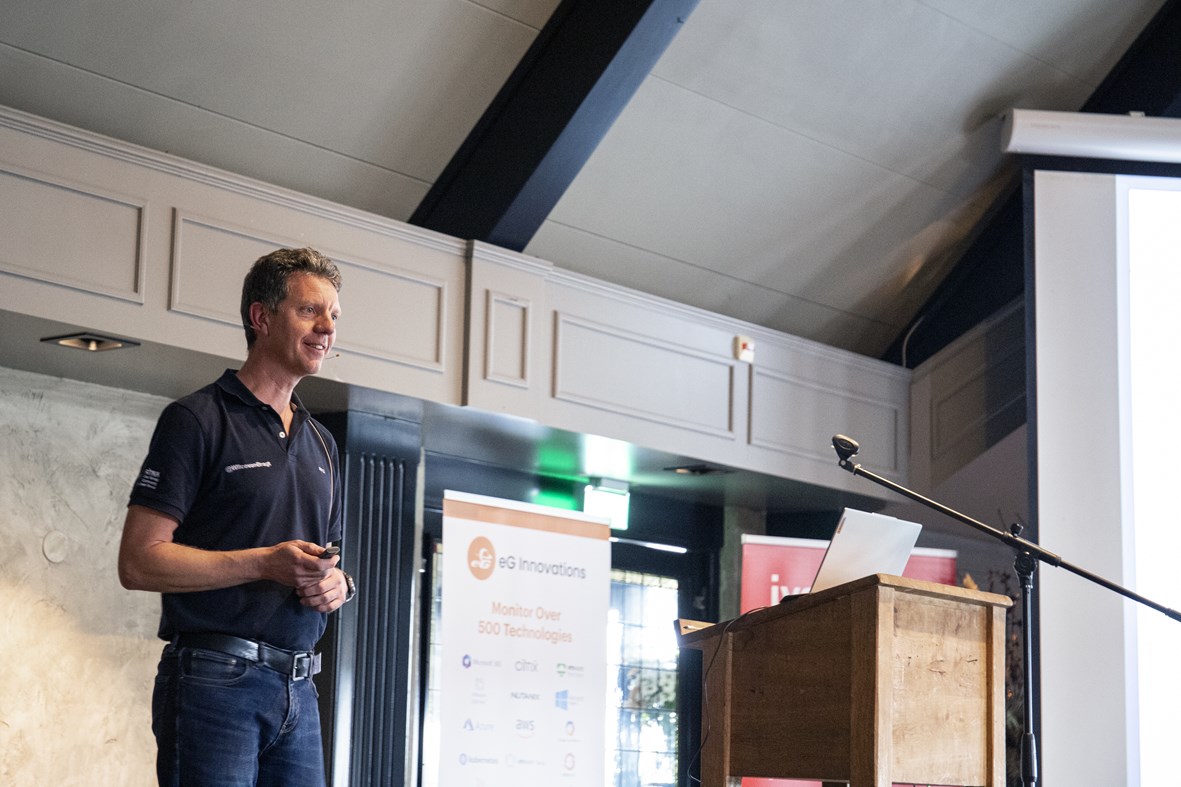On the 3rd of April the first event DuCUG of 2024 took place. My experiences of this day can be read here.
As normal Niek opened the event. He discussed the feedback from the survey of the last event and actions out of the feedback. Logically also the sponsors were thanked for their contribution making this event possible.

The first session was provided by Gerjon Kunst with the title How does Ai impact EUC. The session started with a video showing the possible future with AI. Part 1 of the session was around the topic what is AI. Gerjon was mentioning some examples where AI is used (devices, games, hospitals). Gerjon continued with the history of AI which already started in 1950s - 1970s. Gerjon showed that many companies are working on AI (Nvidia, Google, OpenAI, Microsoft, IBM, Tesla and many more). Next topic was how you can start your journey with AI. Product/Services like ChatGTP/Bard, Dall-E/Midjourney, Synthesia.io 152 best AI tools, enBusiness Application Integrations, custom Large Language Mode were discussed. Microsoft also offers lots of options, like Co-Pilot. Based on Swiss laws only Copilot and Azure OpenAI service are the only ones that comply to the law. Gerjon continued with the Microsoft AI Landscape. Gerjon discussed all kind of current available functionality (wellness/productivity, translation). As a summarization Gerjon discussed the upsides and downsides of AI and discussed the regulation of AI.
The first sponsor session was provided by Christine Chen of UltrArmor. She started with a quick introduction of the company, followed by the philosophy of the company. She continued with the 2024 market trends (cloud-first, multi-cloud, hybrid work). Next topic was a quick overview of their products, followed what they are doing for a sustainable workspace. Also security is discussed within their products. The session was concluded with some customer cases.
After the traditional Bossche Bollen break Patrick van den Born was next on stage with the session Battle of the Desktops: Citrix Virtual Apps and Desktops vs. Azure Virtual Desktop. Patrick started with discussing his feeling that MS is shifting focus to W365 instead of AVD. Next topic was the projects Patrick worked on with AVD and sharing the things that were remarkable (develop desktops were good received, GPU/CAD workloads need wait really long for a VM is available and many bugs, pooled is complex). Biggest Issues were discussed by Patrick like teams offloading (lots of issues), client issues, Remote Apps/EntraID SSO, tags, AVD insights requires a third party product, client mappings less detailed as Citrix. Patrick continued with some challenges with MSIX AppAttach (solved with AppVentiX) as the last topic.
Next was Ingmar Verheij with the BYOS session A introduction in the world of MSIX. Ingmar started off stating the MSIX will be for Microsoft what the IPA format is for Apple. Next Ingmar touched the ways to install applications (exe, msi, appV, AppX) evolving towards MSIX. Next topic was how to get to a MSIX package (from the supplier directly, Microsoft Store, Repackaging, Reverse Packaging). There are two flavors (Native --> Copy on the device or AppAttach --> Mounted on device), Ingmar discussed both the advantages and disadvantages. Next topic was Application Delivery (MS Intune, Azure Portal, Citrix, AppVolumes). Ingmar is using the Tim Mangan Scorecard (App-V 92%, MSIX 82% [with PSF]) to show how many applications can be managed in a MSIX format. The session ended by discussing the content of the MSIX package.
The second sponsor session was provided by deviceTRUST provided by Marc Stieber. Marc started that with the statement that default functionality (device posture scans, conditional access) only checks at the frontdoor, where deviceTRUST contextual security is using context always up to date and real time conditional access. Marc described the functionalities on those two pillars. The product can be used local, remote and SaaS. Marc provided a detailed demo which gave an good overview of the capabilities of the product.
After a fantastic lunch (which is always the case at this location) Dominik Britz from UberAgent/Citrix was on stage with the session Expanding Observability: The Next Chapter for uberAgent as Part of the Citrix Platform. Dominik started with explaining who is/was vast limits. Next topic was how uberAgent fits in the Citrix observability philosophy. Dominik continued with the two products: uberAgent UXM and uberAgent ESA including describing the key features. Within Citrix it will become one product. Next topic were the characteristics of the product (customer value, platform supported, back-end integrations, where Splunk only has dashboards). The new Citrix license models were briefly touched where uberAgent is available within the Citrix Platform License (no stand-alone offering anymore). Next Dominik provided a demo of uberAgent showing features like application network communication, application crashes, application usage, browser web app performance, Machine GPU, Boot Duration, Dominik continued with Citrix uberAgent Endpoint Security Analytics (ESA) by explaining the product does based on the functionality security/compliance inventory (indentify insecure configurations, modular script approach, periodcially checks OS and Apps, comprehensive test included, own tests can be added in any scripting language) and thread detection engine (identify risk or suspicious behavior, continously monitor proces and system behavior).
Nest on stage was Niek Boevink with the session License: good advice, make smart choices and use opportunities. Niek started with the evolvement of the Citrix platform (EUC, Networking, Zero Trust), followed by the fact that NetScaler is now part of the Citrix business unit (which was separated in the beginning with the Cloud Group). Next topic was the App Delivery Infrastructure (Security, Performance, Resiliency, Flexibility, Observability for Experience and Security). The two new licenses are Citrix Universal Hybrid Mulit-Cloud and Citrix Platform License were described including what each license type is offering (check the slide for details). Next to these there are now still two other options (NetScaler Fixed Capacity and Citrix for Private Cloud) for specific use-cases. Last topic was the Citrix Unified Services entitlements (support) possibilities and Citrix consultancy changes.
After the last break we continued with the session Citrix, what's new provided by Rody Kossen. Rody started with the AF1 coding, the April 1 joke. Rody will mainly talk about the CVAD 2402 LTSR release. The 1912 release will be out of support December 24, 2203 out of support march 2027. Rody showed a slide with the enhancements between 2203 and 2402 for HDX and generic (check the slides for all details). Rody continued with topics like the AV1 codec, Enhanced Video Codec selection, Loss tolerant for Graphics, Adaptive Refresh Rate, HDX Audio Enhancements, HDX Direct, Web Studio on-prem, Terraform Provider, Autoscale on-prem, SPA on-prem, Shorten Time to Resolution, Logon Duration Phases and USB Diagnostics tool for Admins. Last topic Rody touched was XenServer by mentioning the XenServer 8 promotion which runs till November 2024.
Ivanti provided the last sponsor session by Lara Hellman. She started off with the discontinuation of Workspace Control and that it will be succeeded by the User Workspace Manager (formerly known as AppSense) product. The benefits were discussed including the components of the product (Environment Manager, Application Control and Performance Manager). Next topic was the Journey to cloud based on three pillars UWM on-prem (traditional), UWM Hybrid (now available) and UWM Neurons (future). She also touched Edge Intelligence and Ivanti Neurons for Application Control (beta in Summer). Last topic discussed was the Ivanti DEX solution.

I was presenting the last session of the day with the presentation Real Life Experiences with Citrix Linux VDA. In this session I started with the history of the Citrix Linux VDA, followed by describing the environment where the real-life experiences were coming from. The session continued with discussing the differences within the CR/LTSR release in comparison with Windows. Other topics were the installation, changed functionality, bugs and support tools. Also the absence of best practices were touches, followed by showing the (im)possibilities of monitoring Citrix Linux VDIs. The session was concluded with the summarization that it is getting better and looks like the attention is there from Citrix.
Also this time there was a possibility to join a wonderful diner, where many attendees were staying to have a nice meal and talk to each other on all kind of topics.
